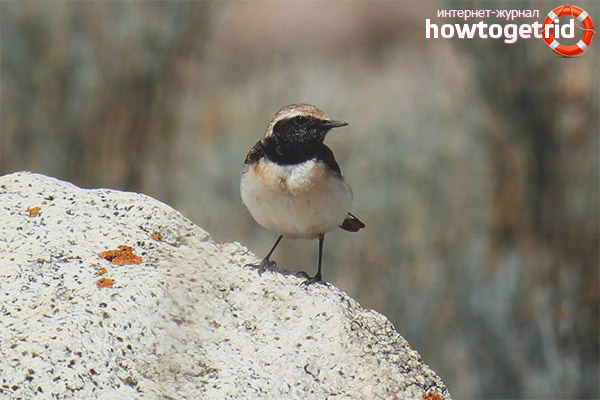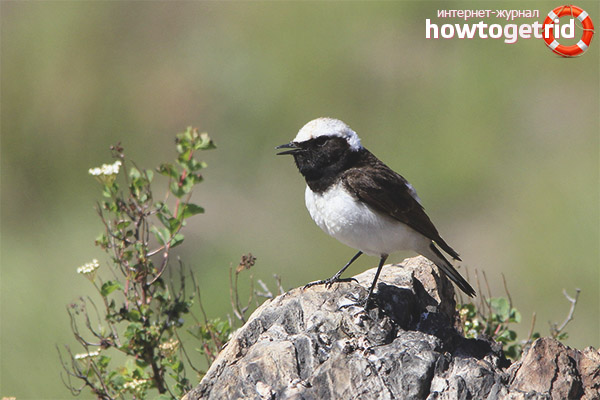The content of the article
This bird lives in the European part of Russia. Belongs to the order of passerines, also relates to the family of thrush.
Kamenka-pleshanka is much smaller than an ordinary Kamenka. The length of her body is only 14 - 18 centimeters. Weight - from 15 to 22 grams. Manners of this kind are similar to manners of an ordinary heater. He loves flying more than moving around the earth.
Description
Males have a peculiar, contrasting color. A head with a former top, like a hat. Small ripples in the form of dark spots sometimes appear on it. The wings of birds are males, black in color from above and from below. The back is also black in color, this differs from other birds of their family, for example, from the Spanish heater. The neck and chest are often black, but individuals with white breasts are also found, which is very rare. Their black mask on the head is connected with black wings, a thin strip on the sides, making it look like a real mask, stretched over the eyes of the heater. The combination of a white hat and a dark mask looks very beautiful.
The female is different in that she does not shine with beauty, she has a dark shade of the entire small body. All its plumage gives a brown tint. In this, it differs from the birds of its family - the common heater.
The male can be distinguished from the female. In the autumn period, a faint reddish pattern appears on her plumage, it is formed from the edges of the feathers of the individual.
Young birds are distinguished by light streaks on their backs. The breast also has a mottled appearance. Females and young birds in autumn are distinguished by the tail pattern. A dark strip appears on their tail, which distinguishes young birds and females. It is very similar to the Spanish Kamenka, but there is one difference - it is a dark back. It is important to note the fact that in the areas of joint habitation, Kamenka hybrids are found.
The voice of the bird
Bird singing sounds very beautiful. It consists of whistles and individual twittering. Often you can hear the sounds of other birds singing elements. There are no rude and hoarse sounds. They like to sing in high places, or rising to the sky. They are able to issue warning signs warning of danger. Small but vociferous.
Spread

The place of residence of the Kamenka-Pleshanka is the steppe massifs. Steppes, deserts - their habitat. Unfortunately, in most of our steppe territories it can be met, although it is possible, but only in rare cases. The bird loves the area, with different types of humps and burrows located on ravines that occur in the steppe massifs. There were cases when she was met in the north in the taiga.
Prepare for the flight later than other birds. Autumn departure takes place from mid to late September. Winter is spent on the African continent.
Lifestyle
It lives in open areas with pronounced relief. Most of all - in hilly steppes, on rocky lunges. He chooses a place of residence on the cliffs of ravines, steep banks, on the ruins of buildings. Nest in shelters between stones, in rock crevices, in crevices of coasts. They like to arrange their nests in holes, the depth of which is 30-35 centimeters. Nesting is done from grass, from the fibers of the bark of a tree, wool, horse hair.
But after the appearance of the chicks, he takes an active part in their feeding. The female and the male take care of the children together, not yielding to each other in agility. According to observations, the bald-headed Kamenka lays eggs only once during the summer. Birds feed on all sorts of insects, and do not refuse from vegetation. They like all kinds of berries, and if somewhere a garden or field with strawberries, this is just right for them.
When autumn comes, they are going to take off again. The path is far, but they are used to wintering in Africa. Next year they will fly again to breed. The life of the birds is interesting. Although they have a tiny body, they have a lot of strength to achieve goals. The bald-headed Kamenka is small, but there are so many beautiful overflows in her singing. Everyone who hears is heard.
Video: Orenanthe pleschanka










Submit